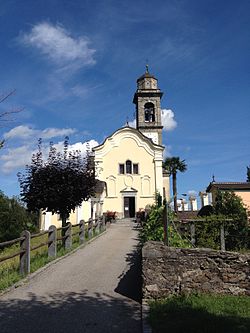Santi Pietro e Paolo (Astano)
| Santi Pietro e Paolo | |
|---|---|
 Facade of the parish church facing the village |
|
| Data | |
| place | Astano |
| Architectural style | Baroque |
| Construction year | 1654 |
| Coordinates | 706945 / 96490 |
The Church of Santi Pietro e Paolo or San Pietro is a Roman Catholic parish church in Astano in the canton of Ticino in Switzerland . It is dedicated to Saints Simon Peter and Paul of Tarsus . The baroque building from 1654 is classified as a cultural asset of regional importance and is a listed building .
history
Astano became an independent parish in 1612 . Then, between 1636 and 1654, the parish church was rebuilt on the fragments of a chapel mentioned in 1444 . Between 1706 and 1707 the church was rebuilt for the first time, and today's main altar was also created. Further restorations followed in 1927, 1943–1947 and 1997 .
Building description
The baroque building has a high tower with an octagonal tower. The facade facing the village is crowned by a curved gable and is provided with a serliana . The whole church is surrounded by the "Via Crucis", a chapel wreath from the years 1806 to 1815. In front of the church portal is an ossuary built in 1721 with a portico supported by Tuscan columns and frescoes from the second half of the 18th century.
The nave has a barrel vault with stitch caps , Ionic bundles of pilasters and a surrounding entablature . The ceiling is painted with illusionistic frescoes from the second half of the 19th century. In the chorus , the 1706-1707 by sculptor Andrea Manni (* 1680) from Rovio main altar created from Arzo - marble with incrustation and statuettenverziertem tabernacle . In the side aisles there are three more chapels and a baptismal niche. In the north aisle there is the baptismal font with stucco from the 18th century, which contains a font from the 17th century. Next to it is a chapel with a painting of the crucified Pope Pius V - and probably also of Saint Vincent Ferrer - from the middle of the 17th century. The Chapel of Our Lady in the south aisle has a polygonal niche from 1721 containing a statue from the 19th century. Next to it is the San Luigi Chapel, which has an altar from 1684 and a painting with the Sacred Heart of Jesus , Saint Joseph , Maria Magdalena , Saint Francis and Saint Aloisius from the 18th century.
Behind the choir is the brotherhood chapel "Oratorio della Confraternita del Rosario", which was built at the beginning of the 18th century and expanded in 1747. She served both the Rosary Brotherhood and the Sacrament Brotherhood , which existed in Astano from 1605 and 1672 respectively. The chapel can only be reached from the outside through a separate entrance, above which there is a window framed with stucco. It contains, among other things, its own altar, a silk processional flag of the two brotherhoods painted in 1848 by Domenico Induno (1815–1878) and a three-part oil painting on canvas from the 17th century. The painting shows how the Astanese pastor Paolo Bacchetta (1600–1672) is said to have escaped three bandits during a robbery on February 19, 1656 thanks to the invocation of the Madonna of Trezzo .
In the south and east, the parish church borders the church cemetery , in which there are several historical family tombs . In the center of the cemetery there is also a plague column from 1687, which commemorates the plague epidemic of the 17th century, which fell victim to a considerable part of the population of Astano.
See also
literature
- Teodoro Amadò: Astano. Gli edifici sacri. In: Almanacco Malcantonese e Valle del Vedeggio. Edizioni Bernasconi, Agno 2002, pp. 68-76.
- Bernardino Croci Maspoli: Astano. In: Historical Lexicon of Switzerland .
- Society for Swiss Art History (Ed.): Art guide through Switzerland. Volume 2: Glarus, Graubünden, Nidwalden, Obwalden, Schwyz, Ticino, Uri. Society for Swiss Art History, Bern 2005, ISBN 3-906131-96-3 , pp. 804–805.
- Celestino Trezzini: Astano. S. 460. (PDF biblio.unibe.ch In: Historisch-Biographisches Lexikon der Schweiz , Volume 1, A - Basel. Neuchâtel 1921.)
Web links
Individual evidence
- ^ B objects TI 2018 . Cantone del Ticino, Inventario PBC, oggetti B, stato 1.1.2018 (nessuna modifica) / Kanton Tessin KGS inventory, B objects, status: 1.1.2018 (no changes). In: babs.admin.ch / kulturgueterschutz.ch. Federal Office for Civil Protection FOCP - Department of Cultural Property Protection, January 1, 2018, accessed on December 31, 2017 (PDF; 481 kB, 10 pages, updated annually, no changes for 2018).
- ↑ Inventory of the cultural assets protected under the Cultural Property Protection Act of May 13, 1997 on the website of the Canton of Ticino. Retrieved August 30, 2019.
- ^ Bernardino Croci Maspoli: Astano. In: Historical Lexicon of Switzerland . 5th June 2014 .
- ↑ Celestino Trezzini : Astano. In: Historisch-Biographisches Lexikon der Schweiz, Volume 1, A - Basel. Neuchâtel 1921, p. 460.
- ↑ a b c Society for Swiss Art History (Ed.): Art guide through Switzerland. Volume 2: Glarus, Graubünden, Nidwalden, Obwalden, Schwyz, Ticino, Uri. Society for Swiss Art History, Bern 2005, ISBN 3-906131-96-3 , pp. 804–805.
- ↑ a b Teodoro Amadò: Astano. Gli edifici sacri. In: Almanacco Malcantonese e Valle del Vedeggio. Edizioni Bernasconi, Agno 2002, p. 74.
- ↑ Paul Imhof: A monument in black and white, a hotel and la gioconda. In: GEO Switzerland. Issue 7, 2014, p. 6.




